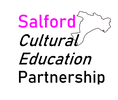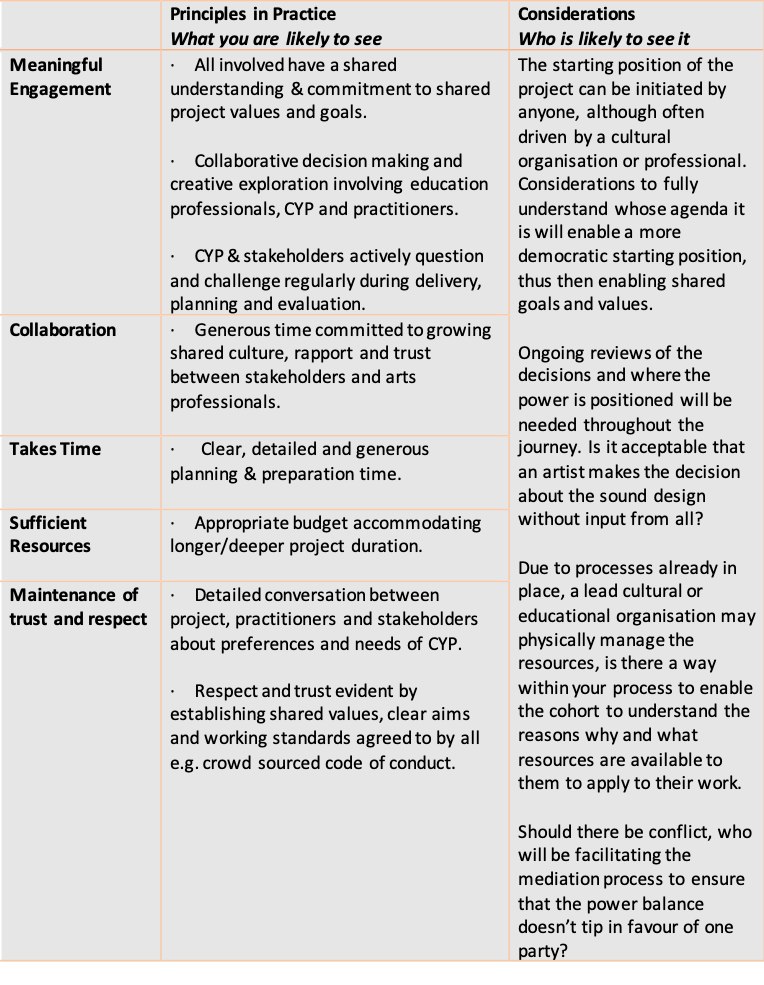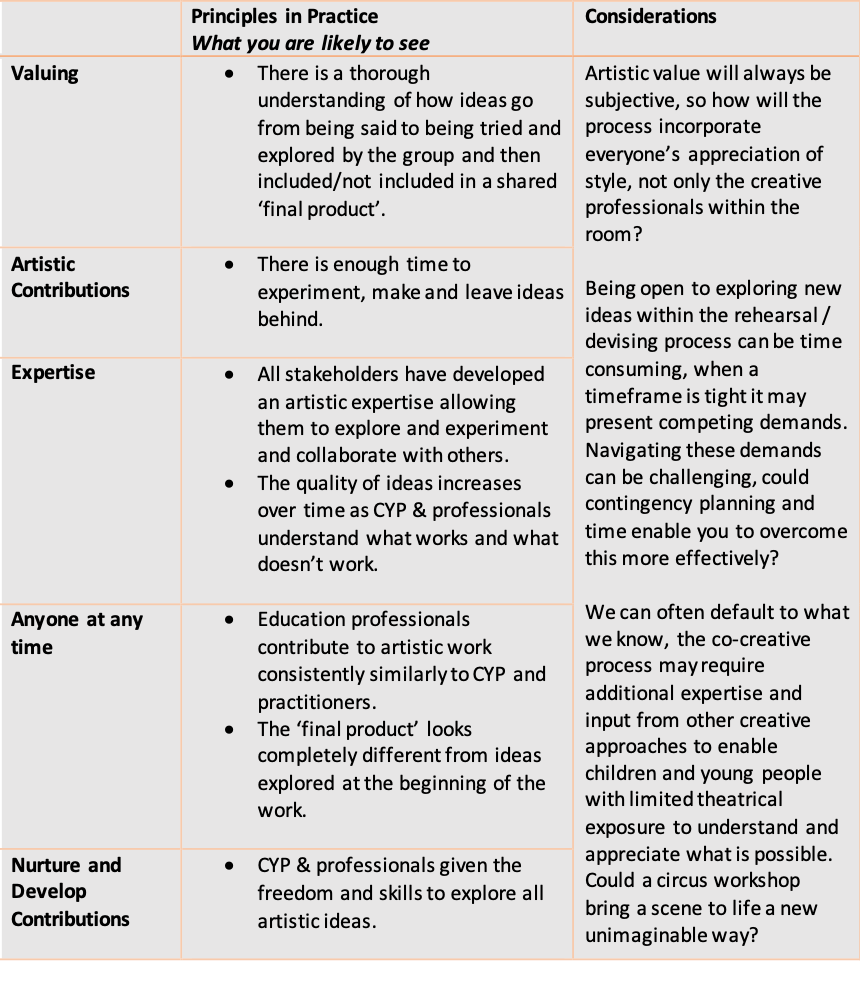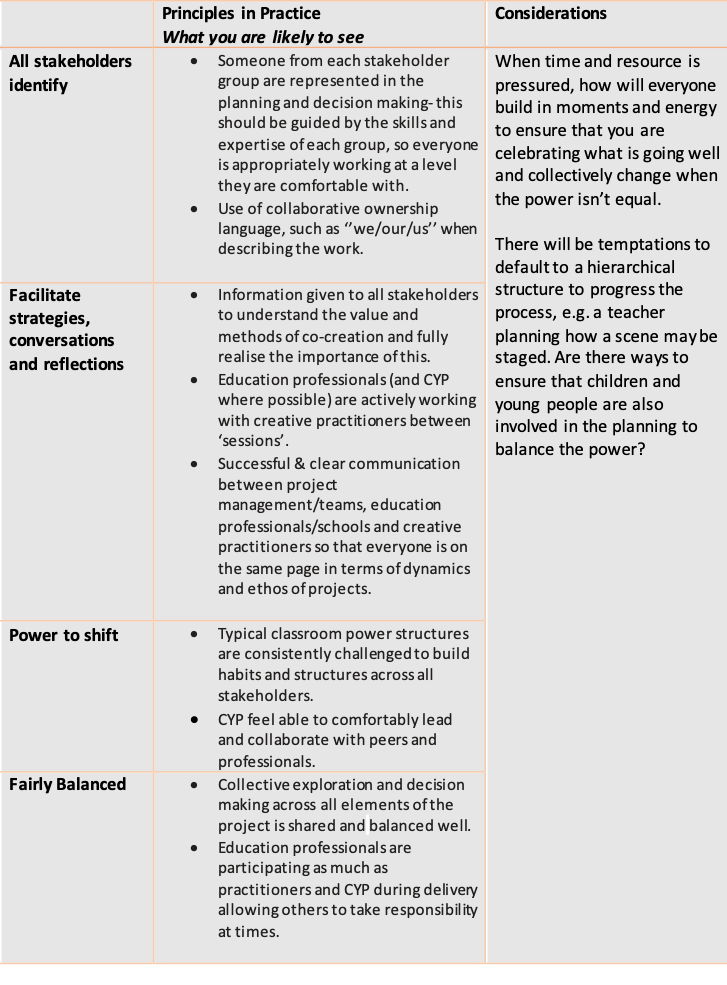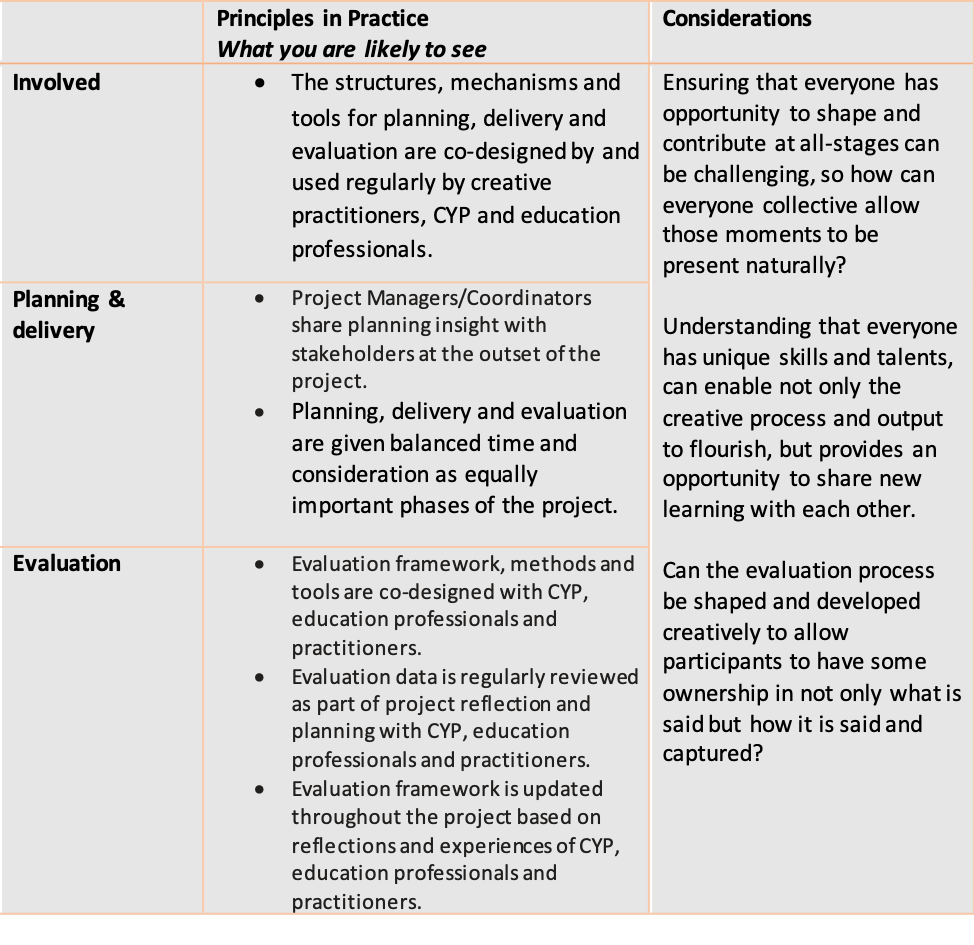Conditions
Before we get into the findings and how you may explore these within your sessions, there needs to be a number of fundamental components in place to ensure the experience for participants, artists and partners are both positive and safe.
(Below are 5 conditions which underpin each of the principles, please scroll through each of them)
(Below are 5 conditions which underpin each of the principles, please scroll through each of them)
The Principles
PRINCIPLE ONE
Meaningful engagement and collaboration between CYP, Creative Practitioners and education professionals takes time; it requires sufficient resources and the creation and maintenance of trust and respect.
|
Meaningful engagement means thinking about the community as a shared partner and a shared leader in the creation of work, in this instance theatre making. We all (collective group) understand that I’m (individually) not moving forward without the communities input and their blessing on whatever initiative we’re working on together. I (artist, professional, young person) need to remember that I’m not the only expert just because I’m coming from cultural organisation, life experience or a specific agenda. Meaningful engagement means we understand that we have an opportunity to learn from our communities. It is a bi-directional learning process. It means we’re coming to the table as equal partners.
Collaboration is a partnership, the act of exploring, producing or making something together. Collaboration can take place between two people or many people, established groups e.g. a Year 5 class or a new cohort that define their own identity. To collaborate is to commit to the possibility of producing an outcome greater than one that would be developed in a silo. Takes time is a critical component of co-creation, unlike other theatre making methodologies the time commitment and personal investment is often greater for all involved. The journey has to focus on the process not the product: Process will enable communities to enjoy and appreciate the journey of making theatre. Product will require steps or direction to make theatre in a way that has a bias from an artist, teacher or professional. Sufficient resources require two key questions which need to be asked prior to any process beginning: can we collectively deliver this project on time and within budget? & can we achieve this without overworking the team? Considerations around this need to factor in a fully realised budget that enables flexibility, planning and prep time for all involved, understanding the pressure points within the process, contingency plans and meetings throughout. Maintenance of trust and respect is both critical and challenging to establish to enable everyone to move forward in the process, initially this will need to be modelled by the facilitator and over time for everyone to be accountable and lead by example. Often within the co-creation process there is an abundance of ideas and contributions: being clear and transparent as to what ideas or elements are taken forward and then keeping to those commitments will harvest both trust and respect. Encouraging everyone to listen to communicate, rather than speaking at all times enables a change in mindset to allow a deeper understanding of those opinions, ideas which may differ from our own. A key element is to ensure that everyone feels safe, not only physically within a room but there is a safety in sharing thoughts and contributing to the creation of something new. |
PRINCIPLE TWO
Valuing the artistic contributions of all involved, appreciating the expertise can be presented by anyone at any time. Consciously providing space and opportunity to nurture and develop contributions.
|
Valuing in relation to the co-created process, recognises that everyone will be able to contribute based on their knowledge, understanding and experience which celebrates every unique member throughout the process. Encouraging everyone to communicate openly, share their thoughts and listen to each other is essential to co-creation working efficiently.
Artistic Contributions can and will come from anywhere, whether they be structural dramaturgical ideas or sound effects within a scene; its about making space to try and explore the options collectively that enables rich learning and understanding of the creative process. Being comfortable artistically in a space where sections can be edited at the 11th hour or new contributions brought to the table which changes the direction of the story, requires patience, trust and importantly time to co-create work in this way. Expertise within your life story can never be taken away from you, so to enable the mantra ‘everyone is an expert’ to resonate, we must first acknowledge this is a reasonable expectation and everyone has that ability to contribute. This may take the form of many things beyond the personal experience, to include things such as skills, understanding, interpretation, knowledge and professional experience. A key role for everyone is to harness all of that during the process to build and create a quality piece of theatre. Anyone at any time means what it says on the tin, this could be a child or young person, an education professional, a creative practitioner, a trainee, a community leader or even a lead artist delivering a masterclass around a theatrical skill. Creating an environment during sessions that enables contributors to share thoughts and ideas, without criticism or limitation, whilst also working closely with those less vocal to encourage anyone at any time to contribute to the structure. To nurture and develop contributions requires time and space to fully explore the opportunities creatively, of which some will move the theatrical piece forward and others won’t. Listening and being present is important to generate a sense of connection ‘there is no such thing as a bad idea’ but we can acknowledge not every idea will be taken forward as it requires universal agreement by all participants. Creating positive experiences for children and young people, especially connected to artistic challenges and successes will build trust and self-confidence and in return likely generate new, engaging and exciting contributions. |
PRINCIPLE THREE
All stakeholders identify where power usually sits and strategies, conversations and reflections are facilitated collectively that will allow this power to shift to ensure the decisions made are fairly balanced.
|
‘All stakeholders Identify’ refers to anyone involved with or has an active interest in the development of the creative work, from conceiving the concept through to evaluation. In relation to these principles, it is likely to include Children and Young People, Education Professionals, Creative Practitioners and any key agencies. It is critical that each stakeholder is equally representative at all stages within the process, this could be everyone at all stages or a smaller cohort that is democratic and has a specific responsibility. E.g. the design of a poster for a production may only require a small number of participants who can work with a designer and then feed back to the wider members.
Strategies, conversations and reflections are facilitated by anyone, but are likely to require a set of skills held by the facilitator(s) that enable space to be generated to listen, amplify voices and stories in the room alongside applying them respectfully to the creative output – this may require additional training or support in advance of the sessions starting. The ability to mediate competing needs, suggestions from anyone at any time, will need to be held sensitively to ensure the space is safe and managed effectively. Often developing a procedure collectively at the start of the journey will enable all to understand how decisions are made. Should the power dynamics change or not be equal, it is important to build in to the planning points of reflection around those moments, which will allow all stakeholders to voice what’s working well and less so. Power to Shift is the key component within the co-creation process in comparison to other creative methodologies, and requires an active mindset to understand and recognise how the balance of power can quickly shift which may or may not favour a particular stakeholder group. Ensuring the decision making doesn’t tip in favour of one cohort, is the responsibility of all not the minority e.g. a creative practitioner.Within education settings, it may require additional work in the lead up to any sessions beginning to establish approaches that are both respectful to the classroom dynamic teacher > student relationship but enable students to have autonomy to lead and shape the direction of the creativity. Fairly balanced approach will ensure that the room recognises that ‘everyone is an expert’ within their own field. A story which focuses on the lives of young people can only be developed by contributions from young people, but artistically a creative practitioner will have strength in presenting those ideas by being an expert within their craft. Both are complimentary to each other, and also allow young people to explore the craft with different approaches whilst the creative lead will be able to interrogate the stories of young people to flesh out those ideas. No one person has ownership of anyone thing, it has to involve everyone to take ownership which is shared. |
PRINCIPLE FOUR
CYP, education professionals and creative practitioners are involved from the outset to inform the planning, delivery and evaluation of the creative process and output. Ensuring at all stages information is shared in an accessible way to enable everyone to make informed decisions that progress the creative journey.
|
To be involved refers to everyone at every stage having opportunity and is actively encouraged to contribute to the development of the work. Appreciating the creation of a project shouldn’t only come from professionals and then presented to participants as an opportunity. Co-creation should be equally shared and owned by all. At each step contributions should be authentic, accessible and tangible that will enable everyone to be involved in whatever way they see appropriate.
Planning and delivery of the work, will have space for anyone to contribute to such as Children and Young People, Education Professionals or Creative Practitioners. Naturally bringing children and young people in to the planning of a project, will need to presented and led in a way which enables them to contribute in a way which is accessible and meaningful. Additional sessions will need to be built into the programme to ensure this is effective and provides space for equity. Evaluation is a key function within the process, which enables everyone to understand the journey and share learnings with others that highlight what is working well and what isn’t. Through co-creation, a framework can be collectively built that not only demonstrates what was achieved but also provides a structure of ways to capture that information that children and young people will access effectively. With the shared ownership of the evaluation, it is more likely that the reporting will be more transparent and genuine because there is equal power in the design and implementation of the framework. Acknowledging that evaluation or stories of change come in many forms, both in a qualitative and quantitative output, and again neither has more weight than the other. A measure of success may focus on ways that a newly formed ensemble share and develop ideas from their 1st session to the last. |
Summary
The principles and information are guidance based on observations, reflections and conversations over a 3 year period. As Stage Directions started out on this journey, we quickly recognised that we all have our own interpretations around Co-Creation, and the detail outlined isn’t fixed but an overview of how co-creation can work with CYP who are making theatre within education and community settings.
Each of the principles is connected to each other, so they can’t be used in isolation although they maybe more prevalent at certain points throughout the journey. They can be adjusted to suit the ethos and goals within a project – they aren’t a hard and fast rule, probably more of a foundation to continue this dialogue over the coming years around co-creation. A key thing is the approach to co-creating work is that the fundamentals require time, energy and resource, this isn’t something which can be applied in a similar fashion to other creative methodologies. Co-Creation can look like many things and the principles encourage slow, considered and layered approaches to the work.
The principles and information are guidance based on observations, reflections and conversations over a 3 year period. As Stage Directions started out on this journey, we quickly recognised that we all have our own interpretations around Co-Creation, and the detail outlined isn’t fixed but an overview of how co-creation can work with CYP who are making theatre within education and community settings.
Each of the principles is connected to each other, so they can’t be used in isolation although they maybe more prevalent at certain points throughout the journey. They can be adjusted to suit the ethos and goals within a project – they aren’t a hard and fast rule, probably more of a foundation to continue this dialogue over the coming years around co-creation. A key thing is the approach to co-creating work is that the fundamentals require time, energy and resource, this isn’t something which can be applied in a similar fashion to other creative methodologies. Co-Creation can look like many things and the principles encourage slow, considered and layered approaches to the work.
